Air Quality and Thermal Environment of Primary School Classrooms with Sustainable Structures in Northern Shaanxi, China: A Numerical Study
Abstract
:1. Introduction
2. Materials and Methods
2.1. Case Description and Measuring Method
2.1.1. Background and Study Case
2.1.2. Test Method and Monitoring Results
2.2. Numerical Model and Simulation Scenarios
2.2.1. Governing Equations and Numerical Implementation
2.2.2. Geometry Model and Mesh Generation
2.2.3. Model Parameters and Boundary Conditions
2.2.4. Simulation Scenarios
3. Results
3.1. Monitoring Results of the Classroom
3.2. Simulation Results and Model Validation
3.3. Air Quality and Thermal Environment Analysis
3.3.1. Effects of Corridors
3.3.2. Effects of Windows
3.3.3. Effects of Seasonal Conditions
3.3.4. Effects of Ventilation Pipe for Underground Air
3.3.5. Effects of Area of the Classroom
4. Discussion
5. Conclusions
- (1)
- The faster the entrance air flow rate in the classroom, the faster the indoor air quality is improved in the case of natural ventilation, and the greater the indoor turbulent velocity. The indoor air quality in the summer will improve faster, thus leading to a larger airflow in the room due to the greater inlet velocity and temperature in the summer.
- (2)
- The underground ventilation pipe will significantly increase the average indoor temperature when the window is opened. The presence of the ventilation pipe will weaken the air quality improvement of the window opening in the room. The larger the width/height ratio, the faster the indoor air quality of the classroom will improve when the window is opened.
- (3)
- When students feel uncomfortable and the indoor air quality is poor, open the window for about 5 min, and the indoor air quality will be significantly improved. When the indoor windows are all closed and there are 45 students in the classroom, the indoor CO2 concentration reaches about 700 ppm in about 74 min. The size design of 9.8 m in length and 7.9 m in width can meet the needs of classroom air quality (for a case with 45 students in the classroom).
- (4)
- For the building structure in Yulin, northern Shaanxi, setting double-sided corridors, underground ventilation corridors, and windows with heights/widths equaling 1 can provide energy-efficient and livable building structures. For cities with similar climate conditions to Yulin, the used sustainable structure and related design in this study could be a practical reference for the construction of classrooms in local primary schools.
Author Contributions
Funding
Institutional Review Board Statement
Informed Consent Statement
Data Availability Statement
Acknowledgments
Conflicts of Interest
References
- Pirouz, B.; Palermo, S.; Naghib, S.; Mazzeo, D.; Turco, M.; Piro, P. The Role of HVAC Design and Windows on the Indoor Airflow Pattern and ACH. Sustainability 2021, 13, 7931. [Google Scholar] [CrossRef]
- Kapoor, N.R.; Kumar, A.; Alam, T.; Kumar, A.; Kulkarni, K.S.; Blecich, P. A Review on Indoor Environment Quality of Indian School Classrooms. Sustainability 2021, 13, 11855. [Google Scholar] [CrossRef]
- Wargocki, P.; Porras-Salazar, J.A.; Contreras-Espinoza, S.; Bahnfleth, W. The relationships between classroom air quality and children’s performance in school. Build. Environ. 2020, 173, 106749. [Google Scholar] [CrossRef]
- Calama-González, C.M.; León-Rodríguez, Á.L.; Suárez, R. Indoor Air Quality Assessment: Comparison of Ventilation Scenarios for Retrofitting Classrooms in a Hot Climate. Energies 2019, 12, 4607. [Google Scholar] [CrossRef]
- Saif, J.; Wright, A.; Khattak, S.; Elfadli, K. Keeping Cool in the Desert: Using Wind Catchers for Improved Thermal Comfort and Indoor Air Quality at Half the Energy. Buildings 2021, 11, 100. [Google Scholar] [CrossRef]
- Chatzidiakou, L.; Mumovic, D.; Summerfield, A.J. What do we know about indoor air quality in school classrooms? A critical review of the literature. Intell. Build. Int. 2012, 4, 228–259. [Google Scholar] [CrossRef]
- Wargocki, P.; Wyon, D.P. Ten questions concerning thermal and indoor air quality effects on the performance of office work and schoolwork. Build. Environ. 2017, 112, 359–366. [Google Scholar] [CrossRef]
- Kaewrat, J.; Janta, R.; Sichum, S.; Kanabkaew, T. Indoor Air Quality and Human Health Risk Assessment in the Open-Air Classroom. Sustainability 2021, 13, 8302. [Google Scholar] [CrossRef]
- Sadrizadeh, S.; Yao, R.; Yuan, F.; Awbi, H.; Bahnfleth, W.; Bi, Y.; Cao, G.; Croitoru, C.; de Dear, R.; Haghighat, F.; et al. Indoor air quality and health in schools: A critical review for developing the roadmap for the future school environment. J. Build. Eng. 2022, 57, 104908. [Google Scholar] [CrossRef]
- Son, S.; Jang, C.-M. Air Ventilation Performance of School Classrooms with Respect to the Installation Positions of Return Duct. Sustainability 2021, 13, 6188. [Google Scholar] [CrossRef]
- Stabile, L.; Massimo, A.; Canale, L.; Russi, A.; Andrade, A.; Dell’Isola, M. The Effect of Ventilation Strategies on Indoor Air Quality and Energy Consumptions in Classrooms. Buildings 2019, 9, 110. [Google Scholar] [CrossRef]
- Chatzidiakou, L.; Mumovic, D.; Summerfield, A.J.; Hong, S.M.; Altamirano-Medina, H. A Victorian school and a low carbon designed school: Comparison of indoor air quality, energy performance, and student health. Indoor Built Environ. 2014, 23, 417–432. [Google Scholar] [CrossRef]
- Stazi, F.; Naspi, F.; D’Orazio, M. Modelling window status in school classrooms. Results from a case study in Italy. Build. Environ. 2017, 111, 24–32. [Google Scholar] [CrossRef]
- Karimipanah, T.; Awbi, H.B.; Sandberg, M.; Blomqvist, C. Investigation of air quality, comfort parameters and effectiveness for two floor-level air supply systems in classrooms. Build. Environ. 2007, 42, 647–655. [Google Scholar] [CrossRef]
- Liu, J.; Yang, X.; Jiang, Q.; Qiu, J.; Liu, Y. Occupants’ thermal comfort and perceived air quality in natural ventilated classrooms during cold days. Build. Environ. 2019, 158, 73–82. [Google Scholar] [CrossRef]
- Ghaffarianhoseini, A.; Berardi, U.; Ghaffarianhoseini, A. Thermal performance characteristics of unshaded courtyards in hot and humid climates. Build. Environ. 2015, 87, 154–168. [Google Scholar] [CrossRef]
- Calautit, J.K.; Tien, P.W.; Wei, S.; Calautit, K.; Hughes, B. Numerical and experimental investigation of the indoor air quality and thermal comfort performance of a low energy cooling windcatcher with heat pipes and extended surfaces. Renew. Energy 2020, 145, 744–756. [Google Scholar] [CrossRef]
- Ahmed, T.; Kumar, P.; Mottet, L. Natural ventilation in warm climates: The challenges of thermal comfort, heatwave resilience and indoor air quality. Renew. Sustain. Energy Rev. 2021, 138, 110669. [Google Scholar] [CrossRef]
- Li, Y.; Xie, Z.X.; Qin, Y.C.; Xia, H.M.; Zheng, Z.C.; Zhang, L.J.; Pan, Z.W.; Liu, Z.Z. Drought Under Global Warming and Climate Change: An Empirical Study of the Loess Plateau. Sustainability 2019, 11, 1281. [Google Scholar] [CrossRef]
- Dong, J.; Chen, Z.; Zhang, L.; Cheng, Y.; Sun, S.; Jie, J. Experimental investigation on the heating performance of a novel designed trombe wall. Energy 2018, 168, 728–736. [Google Scholar] [CrossRef]
- Bakó-Biró, Z.; Clements-Croome, D.J.; Kochhar, N.; Awbi, H.B.; Williams, M.J. Ventilation rates in schools and pupils’ performance. Build. Environ. 2012, 48, 215–223. [Google Scholar] [CrossRef]
- Kabanshi, A.; Wigö, H.; Sandberg, M. Experimental evaluation of an intermittent air supply system—Part 1: Thermal comfort and ventilation efficiency measurements. Build. Environ. 2016, 95, 240–250. [Google Scholar] [CrossRef]
- Center, N.M.I. China Meterorological Data Service Center. 2020. Available online: http://data.cma.cn/en (accessed on 10 June 2020).
- Wilcox, D.C. Turbulence Modeling for CFD, 3rd ed.; Dcw Industries, Incorporated: La Cañada Flintridge, CA, USA, 2006. [Google Scholar]
- Zhang, T.T.; Lee, K.; Chen, Q.Y. A simplified approach to describe complex diffusers in displacement ventilation for CFD simulations. Indoor Air 2009, 19, 255–267. [Google Scholar] [CrossRef] [PubMed]
- Lin, Z.; Chow, T.T.; Wang, Q.; Fong, K.F.; Chan, L.S. Validation of CFD Model for Research into Displacement Ventilation. Arch. Sci. Rev. 2005, 48, 305–316. [Google Scholar] [CrossRef]
- Hussain, S.; Oosthuizen, P.; Kalendar, A. Evaluation of various turbulence models for the prediction of the airflow and temperature distributions in atria. Energy Build. 2012, 48, 18–28. [Google Scholar] [CrossRef]
- Putra, J.C.P. A Study of Thermal Comfort and Occupant Satisfaction in Office Room. Procedia Eng. 2017, 170, 240–247. [Google Scholar] [CrossRef]
- Asmi, A.; Putra, J.C.P.; Rahman, I.A. Simulation of Room Airflow Using Comsol Multiphysics Software. Appl. Mech. Mater. 2013, 465–466, 571–577. [Google Scholar] [CrossRef]
- Wang, X. Experimental Study of Human Carbon Dioxide Generation Rate at Different Activity Levels. Master’s Thesis, Xi’an University of Architecture and Technology, Xi’an, China, 2021. [Google Scholar]
- Li, C.; Wu, P.T.; Li, X.L.; Zhou, T.W.; Sun, S.K.; Wang, Y.B.; Luan, X.B.; Yu, X. Spatial and temporal evolution of climatic factors and its impacts on potential evapotranspiration in Loess Plateau of Northern Shaanxi, China. Sci. Total Environ. 2017, 589, 165–172. [Google Scholar] [CrossRef]
- Chenari, B.; Dias Carrilho, J.; Gameiro da Silva, M. Towards sustainable, energy-efficient and healthy ventilation strategies in buildings: A review. Renew. Sustain. Energy Rev. 2016, 59, 1426–1447. [Google Scholar] [CrossRef]
- Posner, J.; Buchanan, C.; Dunn-Rankin, D. Measurement and prediction of indoor air flow in a model room. Energy Build. 2002, 35, 515–526. [Google Scholar] [CrossRef]
- Zhu, C.; Li, N. Study on indoor air quality evaluation index based on comfort evaluation experiment. Procedia Eng. 2017, 205, 2246–2253. [Google Scholar] [CrossRef]
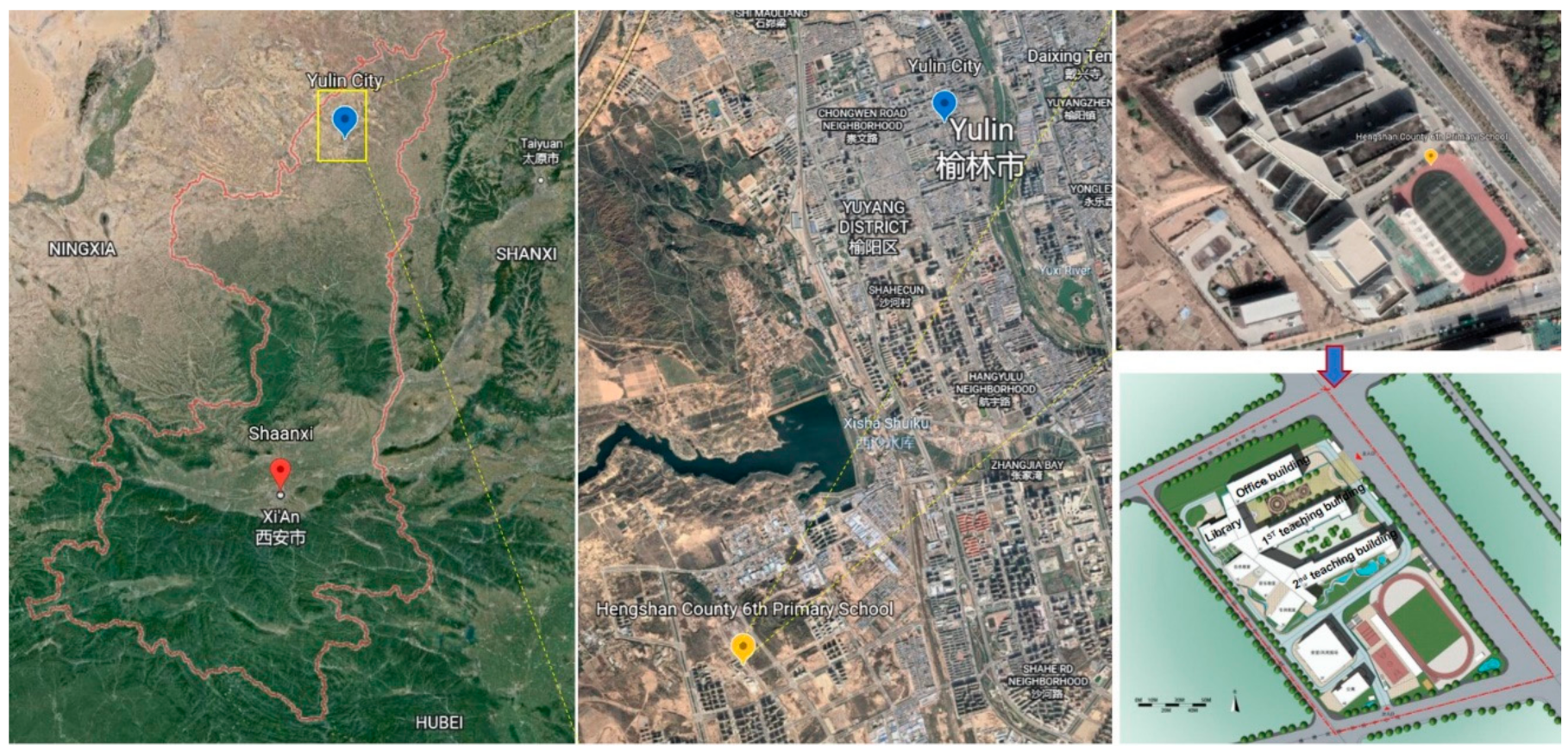
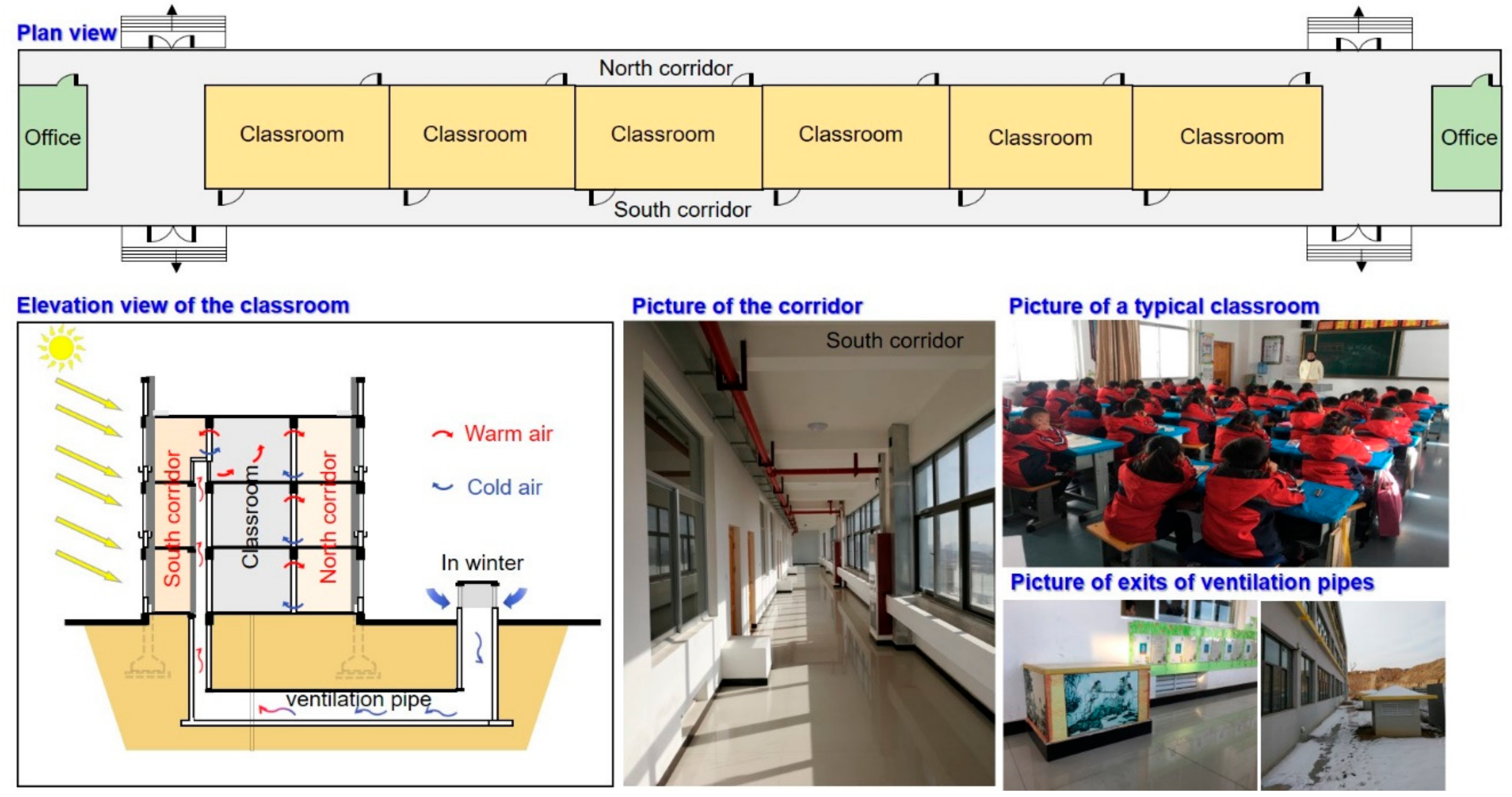
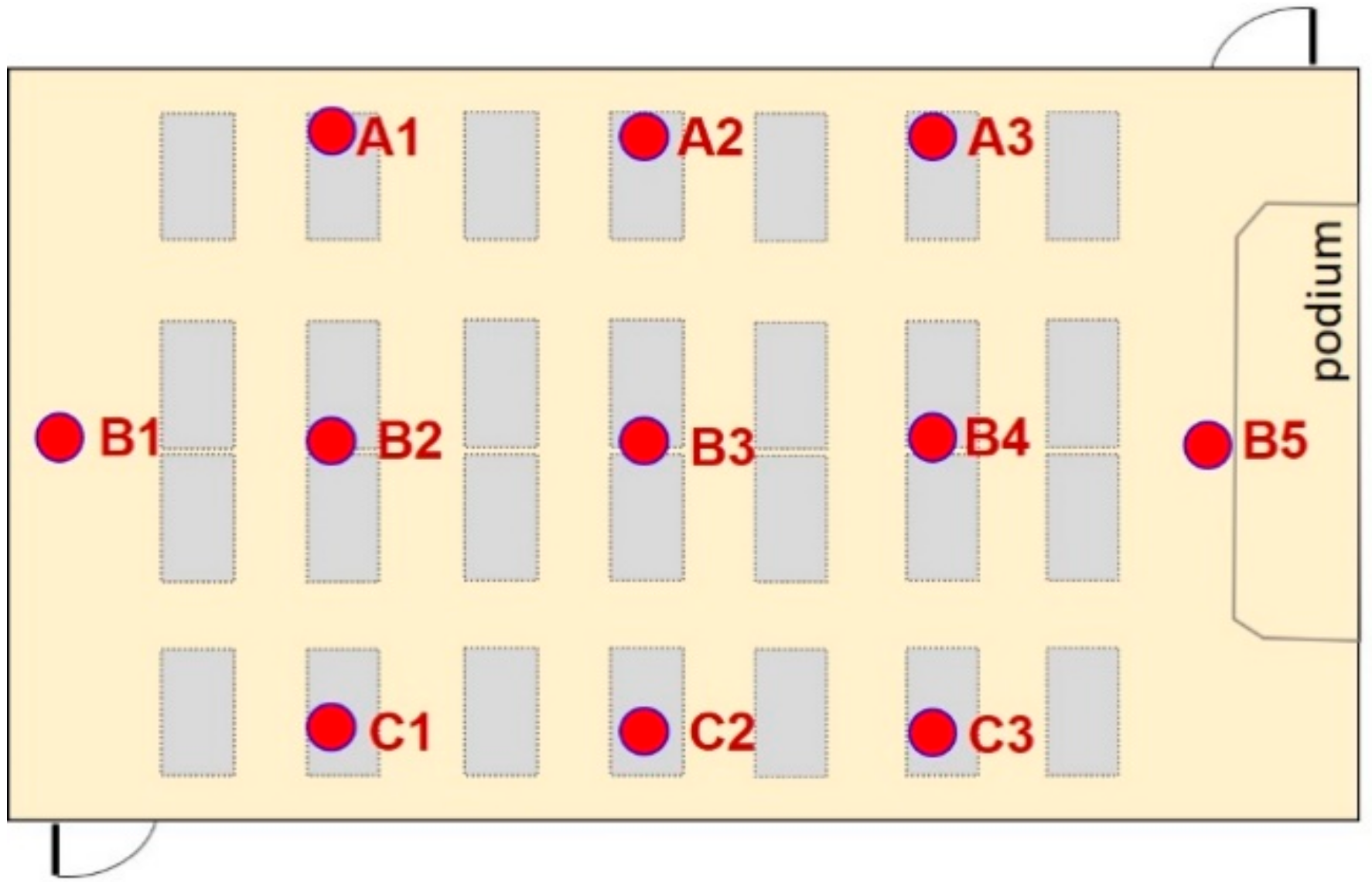
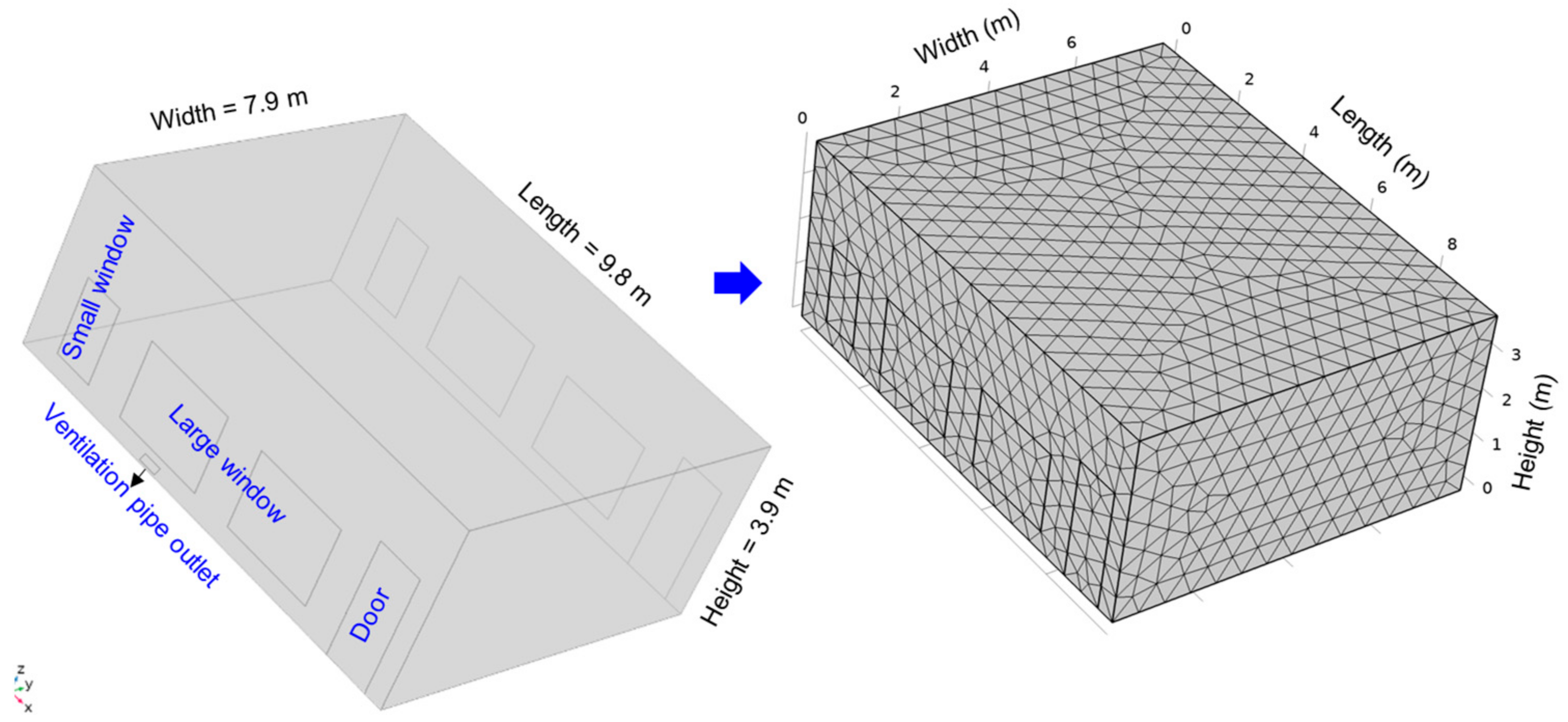
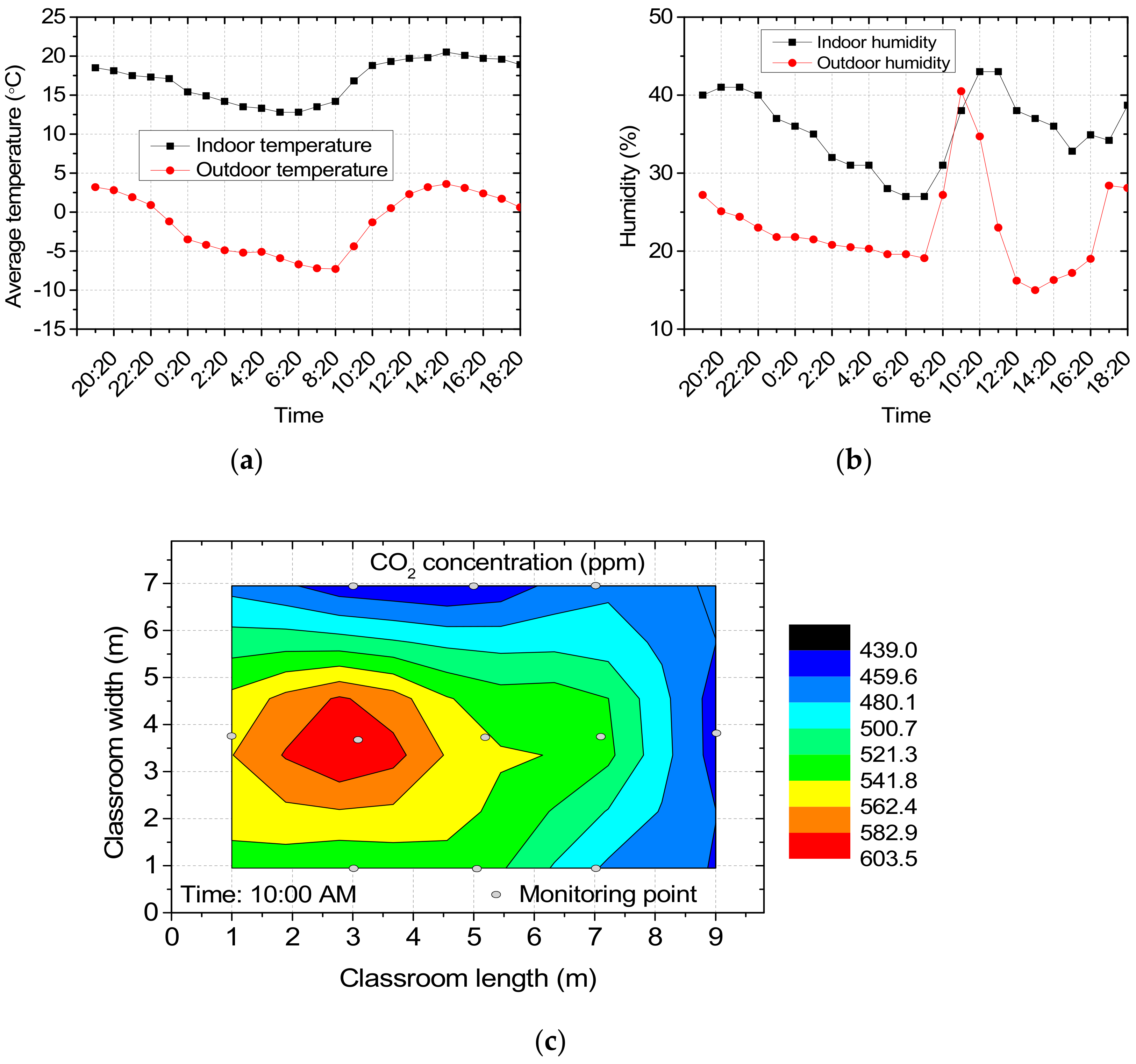
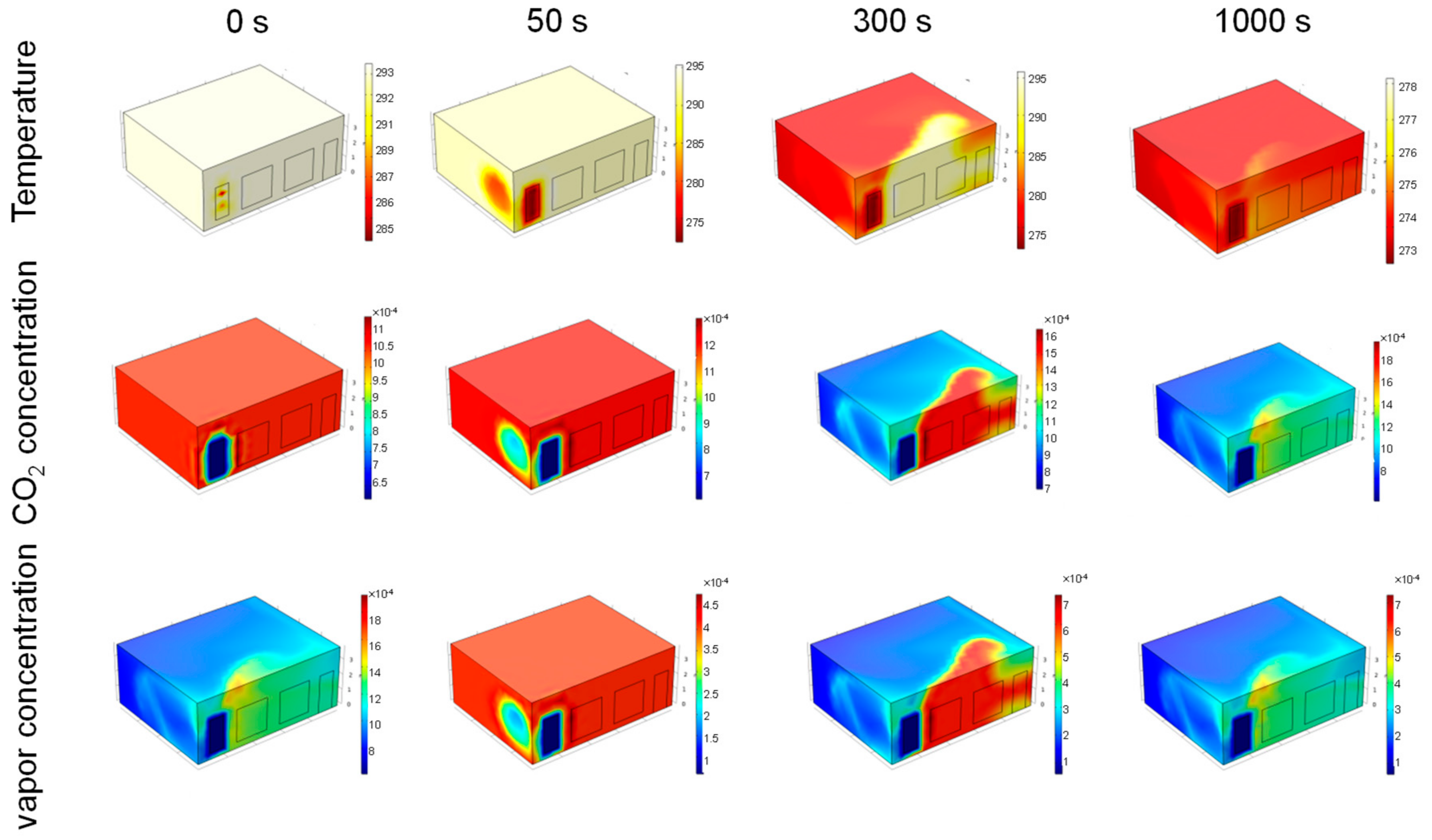
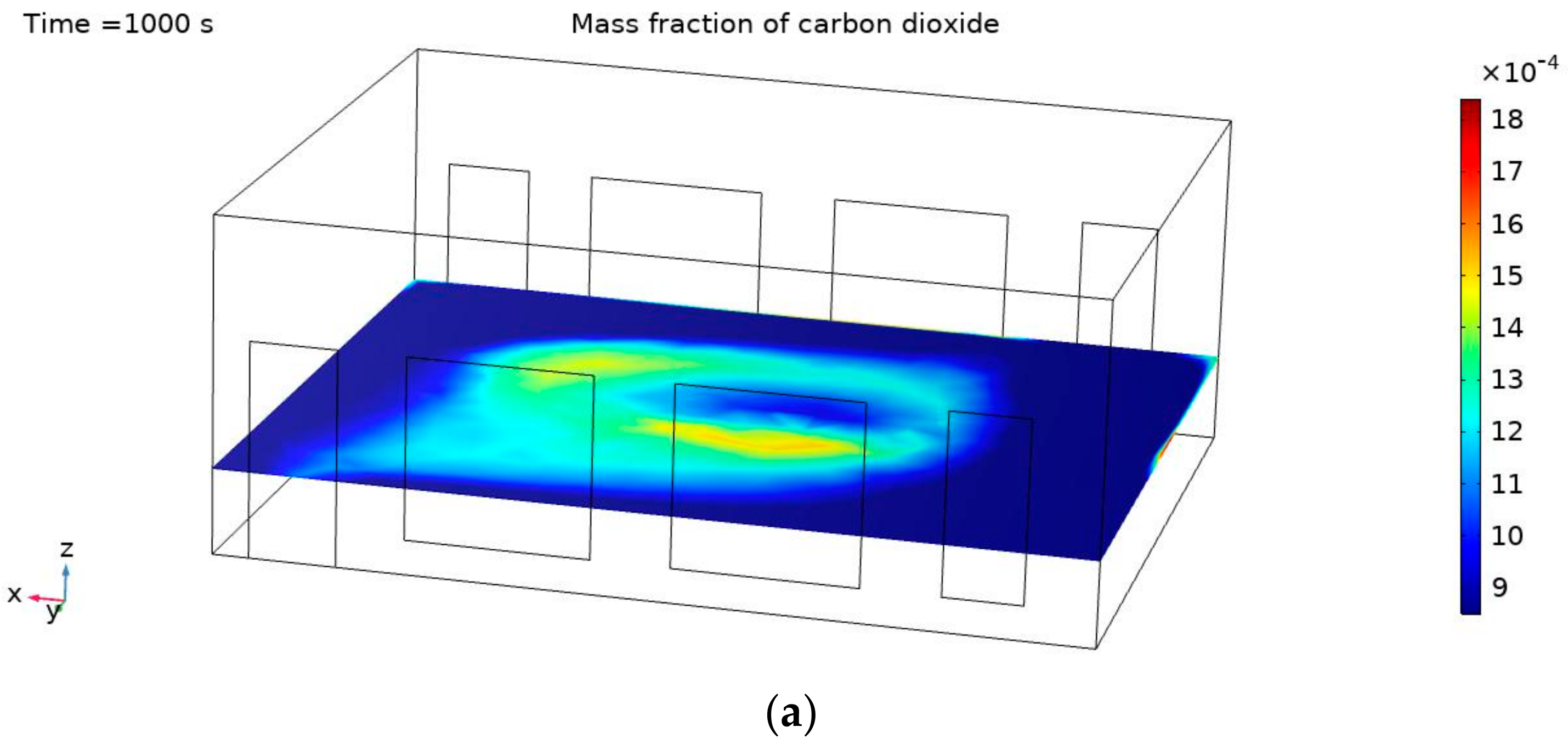
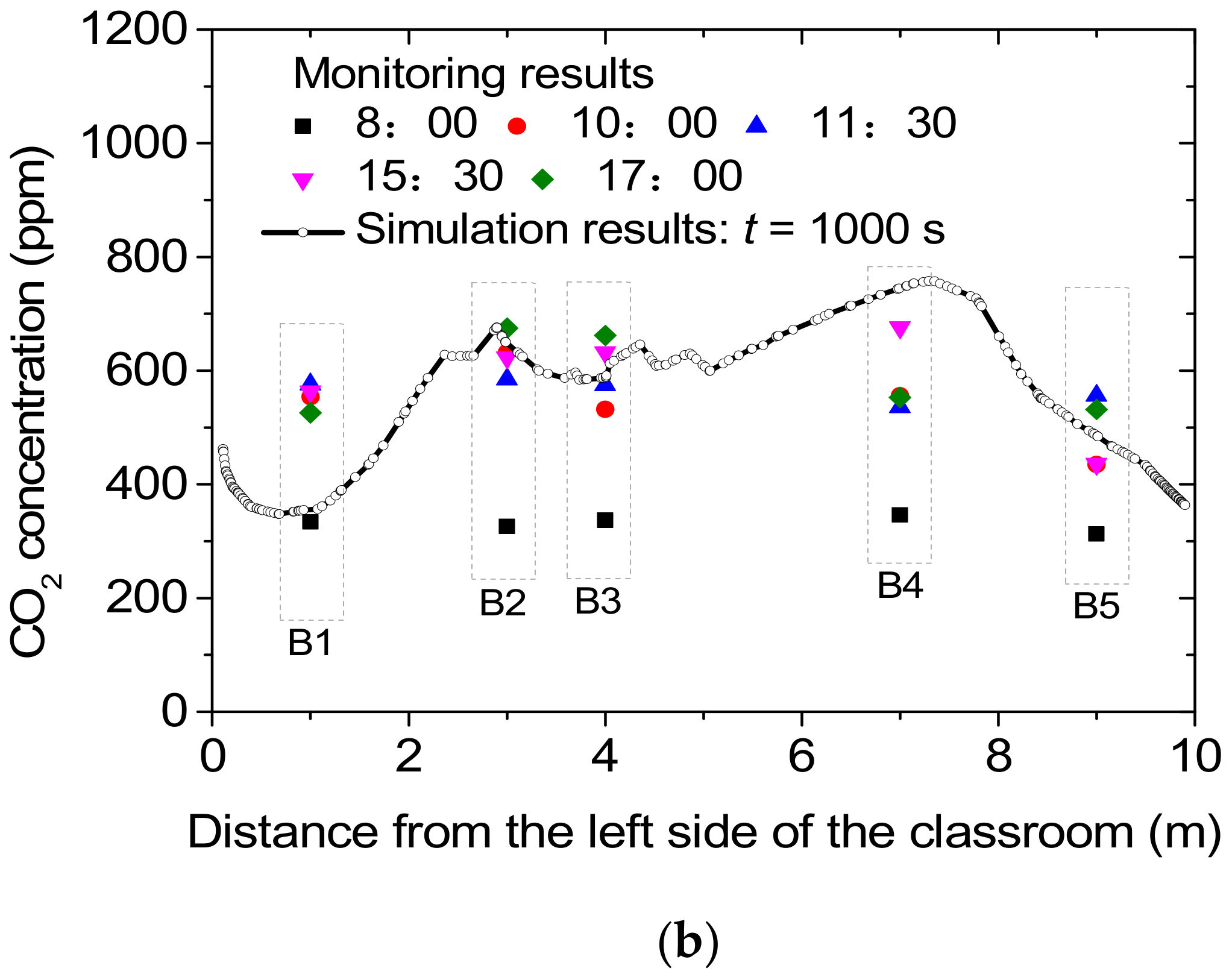
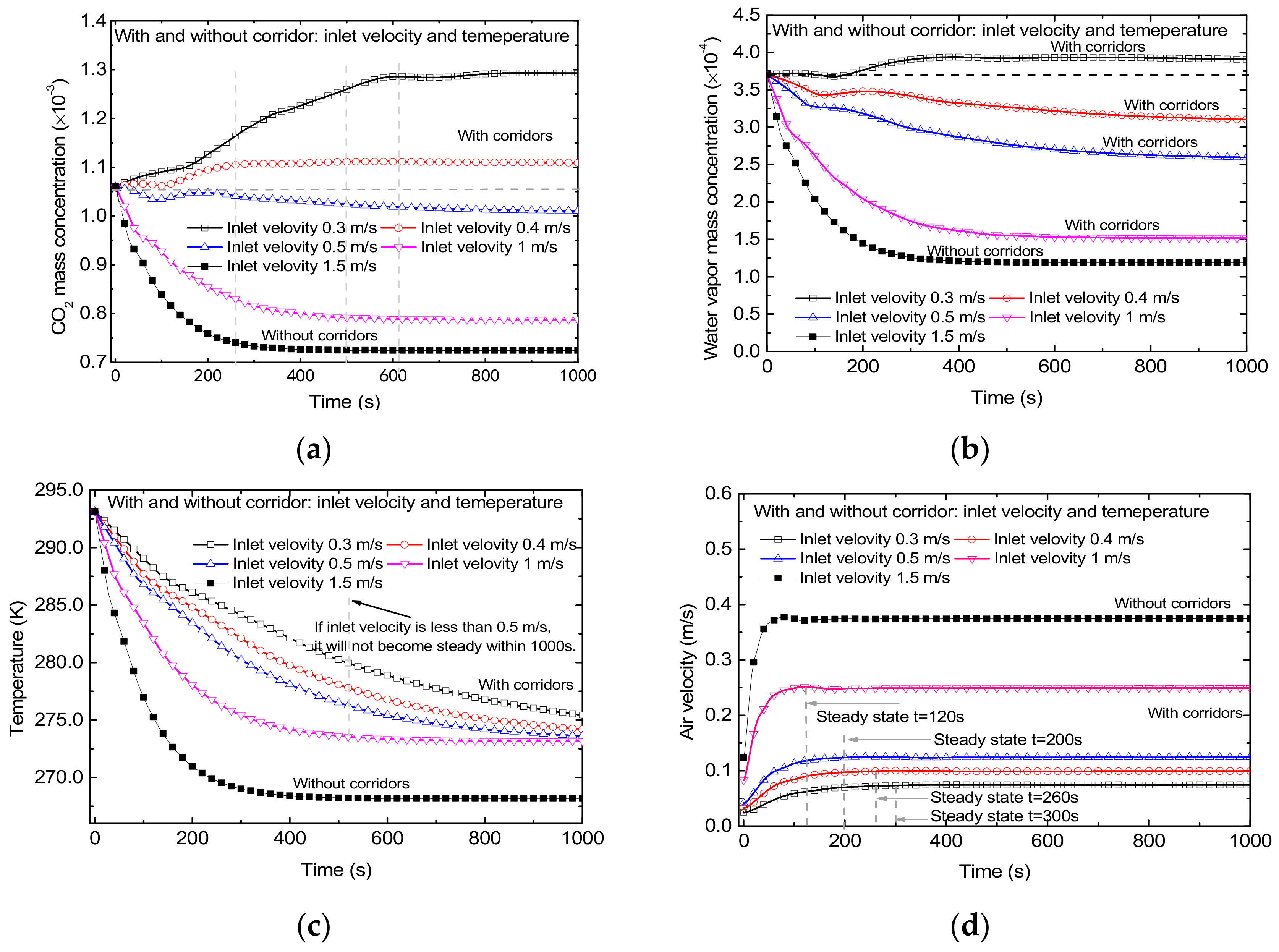
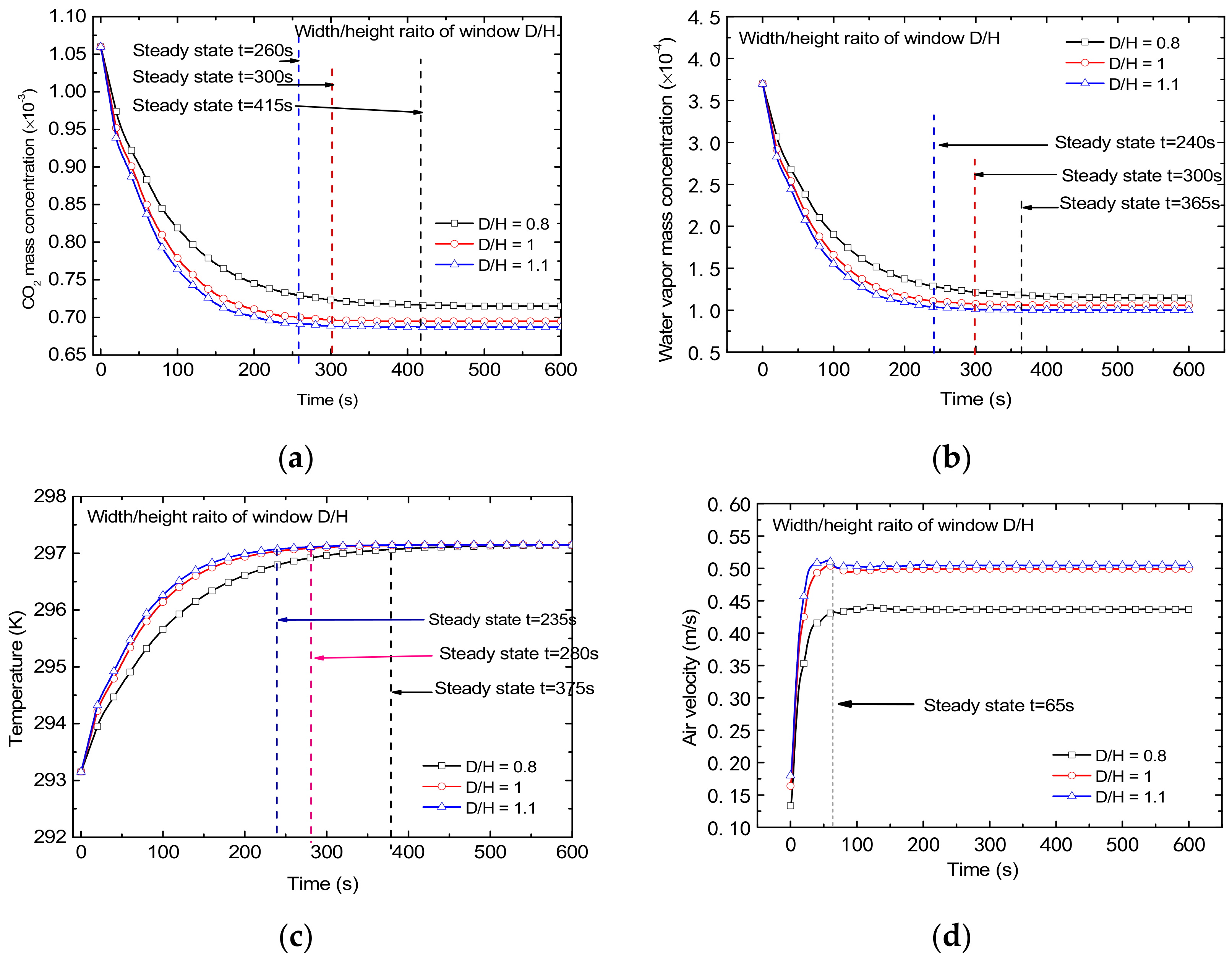
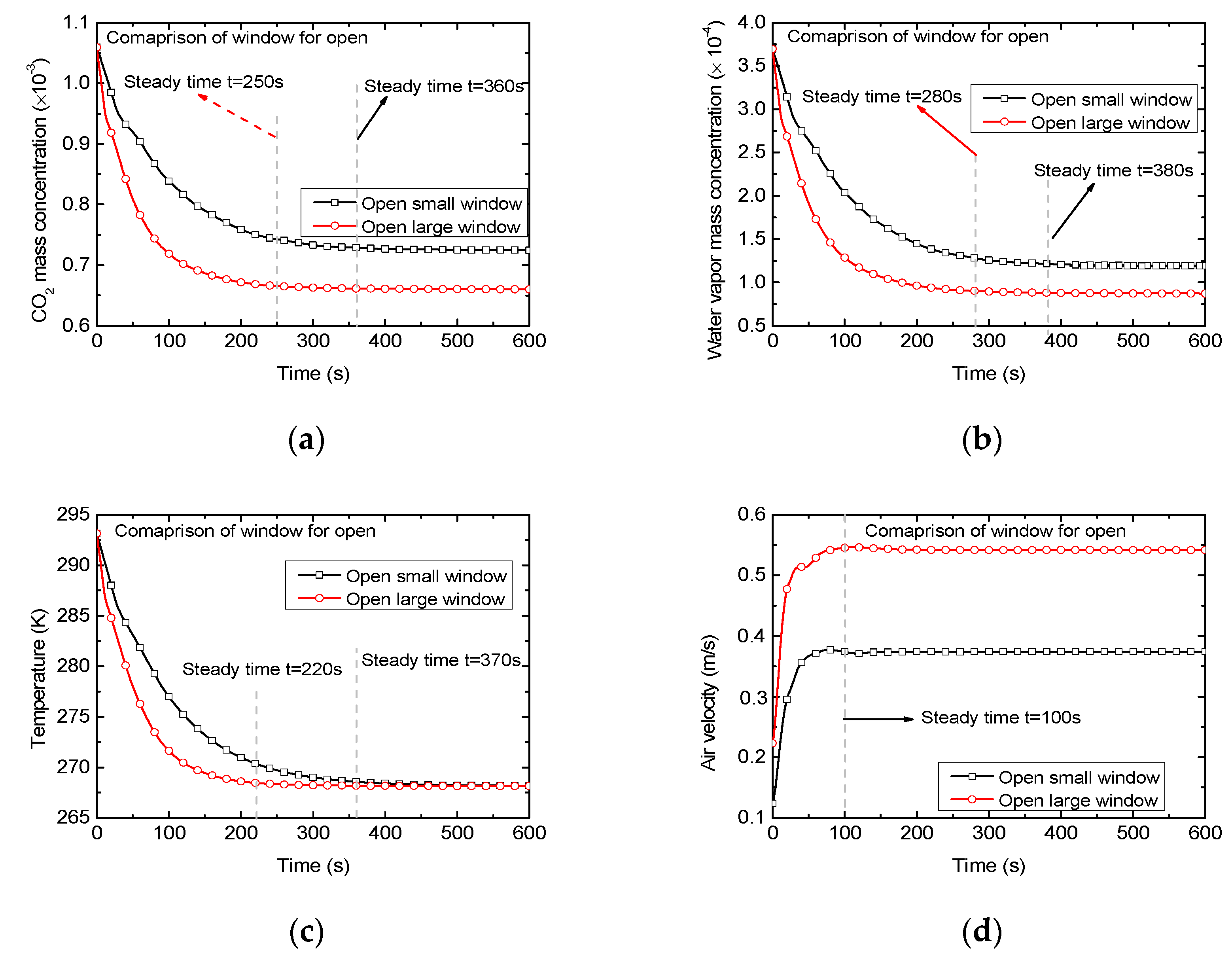
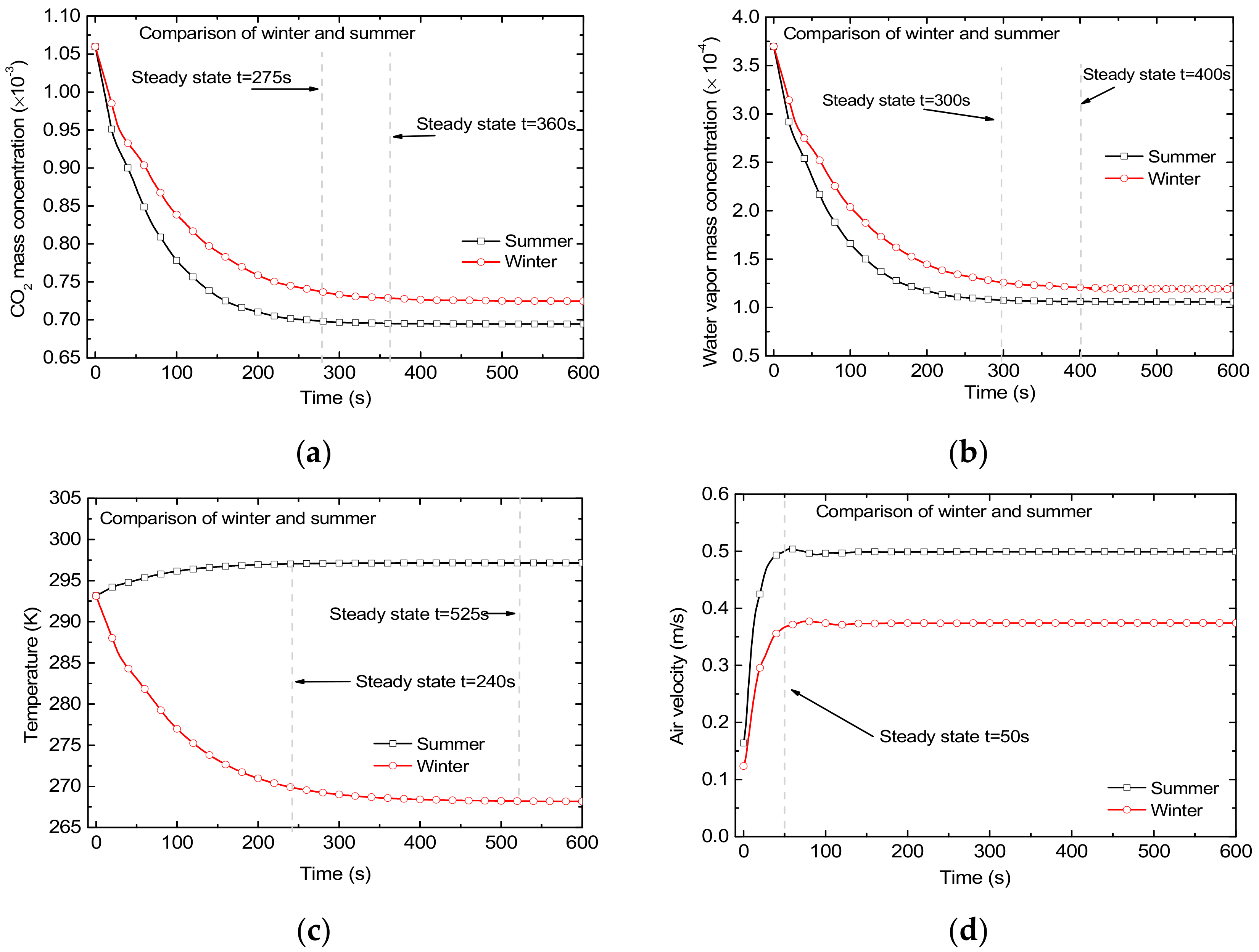
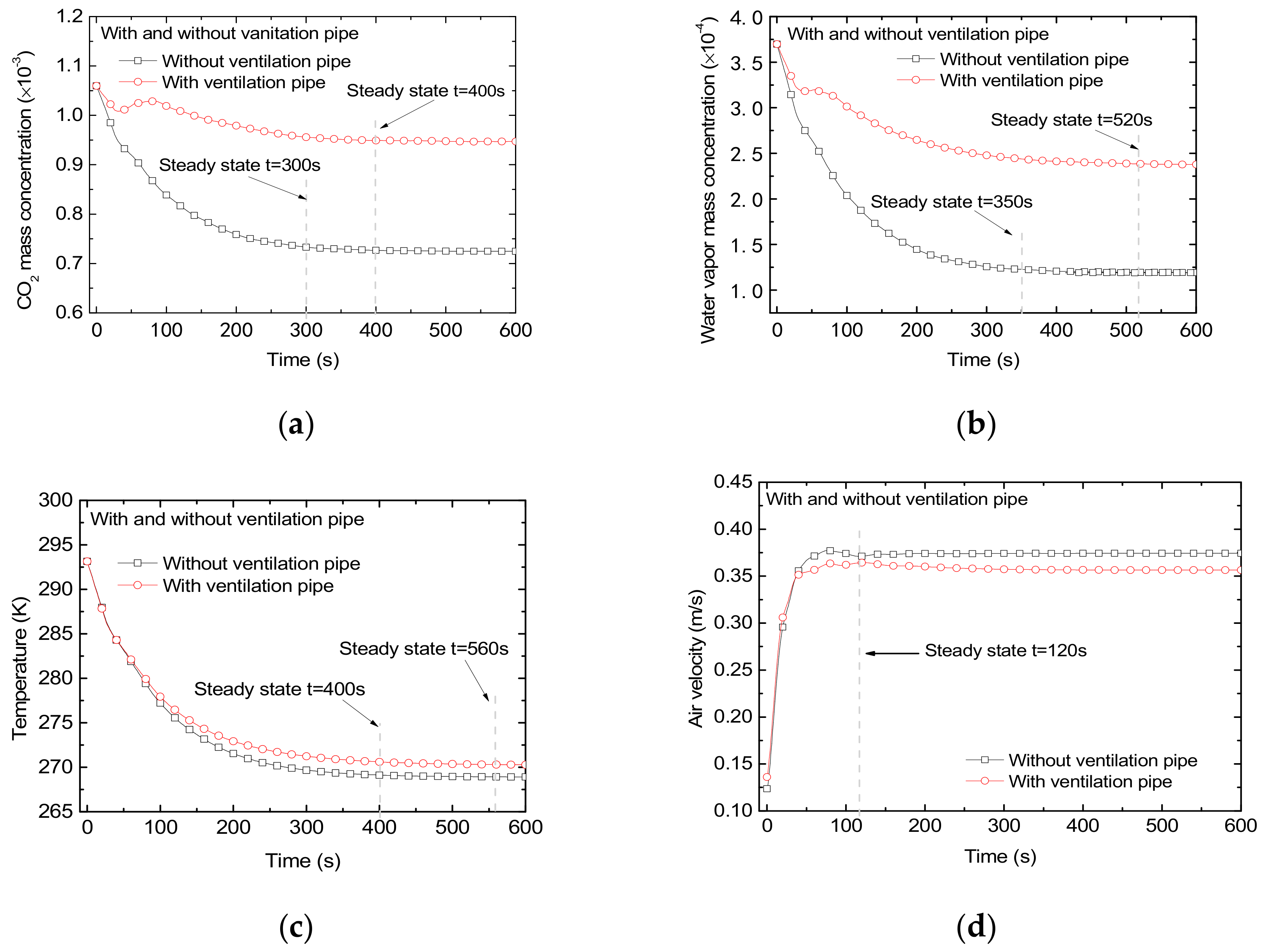
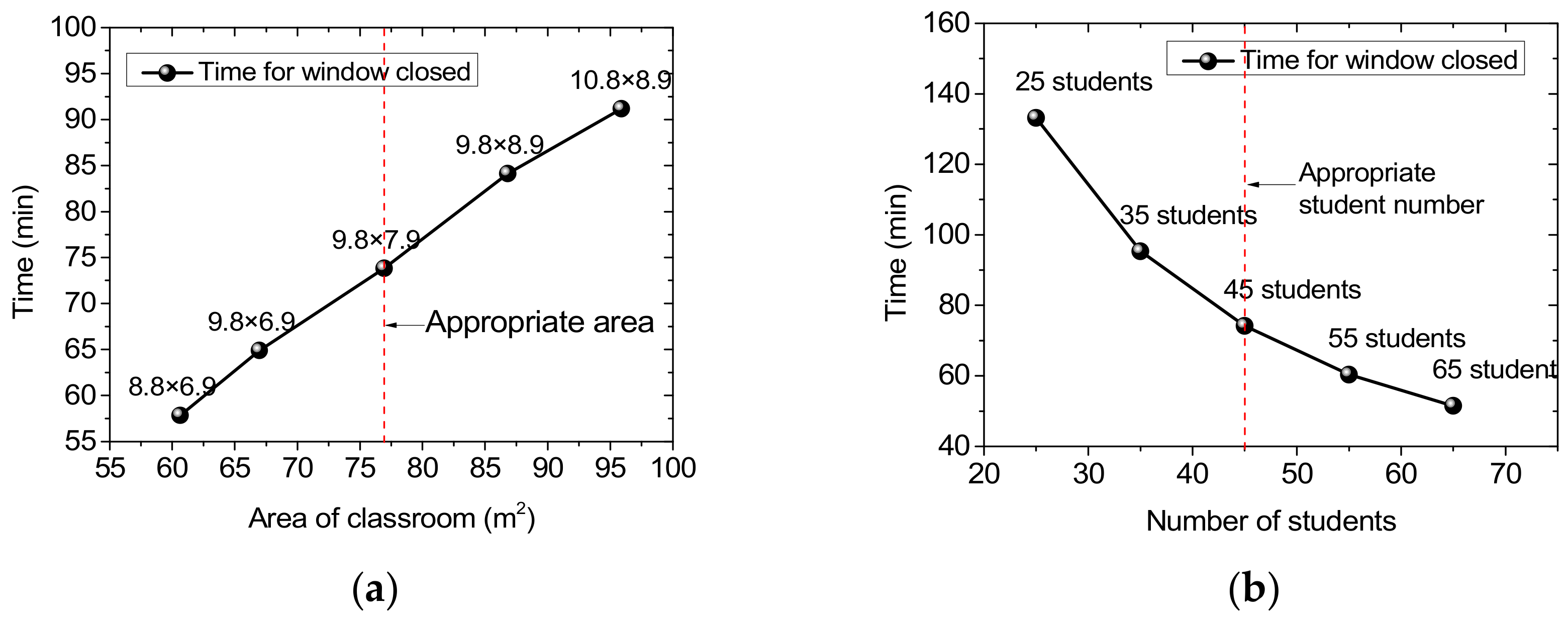
| Item | Number | Size (m) |
|---|---|---|
| Small window | 2 | 0.9 × 2.1 m |
| Large window | 4 | 2.1 × 2.1 m |
| Door | 2 | 1 × 2.5 m |
| Classroom | 1 | 9.8 × 7.9 × 3.9 m |
| Ventilation pipe | 2 | 0.45 × 0.56 m |
| Boundary | Physical Variables | Value | Unit |
|---|---|---|---|
| Inlet | Velocity | Fixed value | m/s |
| Temperature | Fixed value | °C | |
| CO2 concentration | 400 | ppm | |
| Water vapor concentration | 200 | ppm | |
| Outlet | Pressure | 0 | Pa |
| Bottom | CO2 source | 32 g/h/student | g |
| Water vapor source | 16.7 g/h/student | g | |
| Top and sides | Pressure | No slip | / |
| Temperature | Zero flux | / |
| Case | Ventilation Pipe | Corridors | Intel | Initial Condition | Width/Height of Window | |||
|---|---|---|---|---|---|---|---|---|
| CO2 Concentration (ppm) | Temperature (°C) | Velocity (m/s) | CO2 Concentration (ppm) | Temperature (°C) | ||||
| 1 | No | Yes | 400 | 0 | 0.3 | 750 | 20 | 1:1 |
| 2 | No | Yes | 400 | 0 | 0.4 | 750 | 20 | 1:1 |
| 3 | No | Yes | 400 | 0 | 0.5 | 750 | 20 | 1:1 |
| 4 | No | No | 400 | 0 | 1 | 750 | 20 | 1:1 |
| 5 | No | No | 400 | −5 | 1.5 | 750 | 20 | 1:1 |
| 6 | No | No | 400 | 24 | 2 | 750 | 20 | 1.1:1 |
| 7 | No | No | 400 | 24 | 2 | 750 | 20 | 0.8 |
| 8 | No | No | 400 | 24 | 2 | 750 | 20 | 1 |
| 9 | Yes | No | 400 | −5 | 1.5 | 750 | 20 | 1 |
| 10 | No | No | 400 | −5 (large window) | 1.5 | 750 | 20 | 1 |
| Time | CO2 Concentration (ppm) | ||||||||||
|---|---|---|---|---|---|---|---|---|---|---|---|
| A1 | A2 | A3 | B1 | B2 | B3 | B4 | B5 | C1 | C2 | C3 | |
| 8:00 | 331 | 332 | 311 | 334 | 326 | 337 | 346 | 313 | 323 | 327 | 299 |
| 10:00 | 443 | 435 | 478 | 554 | 632 | 532 | 556 | 435 | 521 | 535 | 478 |
| 11:30 | 553 | 577 | 525 | 576 | 585 | 575 | 536 | 556 | 521 | 556 | 498 |
| 15:00 | 568 | 524 | 537 | 563 | 623 | 632 | 676 | 436 | 457 | 665 | 522 |
| 17:00 | 523 | 415 | 535 | 526 | 675 | 662 | 553 | 532 | 523 | 611 | 567 |
Publisher’s Note: MDPI stays neutral with regard to jurisdictional claims in published maps and institutional affiliations. |
© 2022 by the authors. Licensee MDPI, Basel, Switzerland. This article is an open access article distributed under the terms and conditions of the Creative Commons Attribution (CC BY) license (https://creativecommons.org/licenses/by/4.0/).
Share and Cite
Lan, K.; Chen, Y. Air Quality and Thermal Environment of Primary School Classrooms with Sustainable Structures in Northern Shaanxi, China: A Numerical Study. Sustainability 2022, 14, 12039. https://doi.org/10.3390/su141912039
Lan K, Chen Y. Air Quality and Thermal Environment of Primary School Classrooms with Sustainable Structures in Northern Shaanxi, China: A Numerical Study. Sustainability. 2022; 14(19):12039. https://doi.org/10.3390/su141912039
Chicago/Turabian StyleLan, Kun, and Yang Chen. 2022. "Air Quality and Thermal Environment of Primary School Classrooms with Sustainable Structures in Northern Shaanxi, China: A Numerical Study" Sustainability 14, no. 19: 12039. https://doi.org/10.3390/su141912039
APA StyleLan, K., & Chen, Y. (2022). Air Quality and Thermal Environment of Primary School Classrooms with Sustainable Structures in Northern Shaanxi, China: A Numerical Study. Sustainability, 14(19), 12039. https://doi.org/10.3390/su141912039





